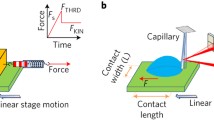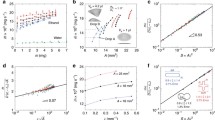Abstract
Drops moving on a substrate under the action of gravity display both rolling and sliding motions. The two limits of a thin sheet-like drop in sliding motion on a surface, and a spherical drop in roll, have been extensively studied. We are interested in intermediate shapes. We quantify the contribution of rolling motion for any intermediate shape, and recently obtained a universal curve for the amount of roll as a function of a shape parameter using hybrid lattice Boltzmann simulations. In this paper, we discuss the linear relationship which is expected between the Capillary and Bond numbers, and provide detailed confirmation by simulations. We also show that the viscosity of the surrounding medium can qualitatively affect dynamics. Our results provide an answer to a natural question of whether drops roll or slide on a surface and carry implications for various applications where rolling motion may or may not be preferred.







Similar content being viewed by others
References
P G de Gennes, F Brochard-Wyart and D Quere, Capillarity and wetting phenomena: Drops, bubbles, pearls, waves (Springer, Spring Street, New York, USA, 2004)
S P Thampi and R Govindarajan, Phys. Rev. E 84, 046304 (2011)
P T Sumesh and R Govindarajan, J. Chem. Phys. 133, 144707 (2010)
J P Rothstein, Annu. Rev. Fluid Mech. 42, 89 (2010)
E B Dussan and R T Chow, J. Fluid Mech. 137, 1 (1983)
N Le Grand, A Daerr and L Limat, J. Fluid Mech. 541, 293 (2005)
J H Snoeijer, E Rio, N Le Grand and L Limat, Phys. Fluids 17, 072101 (2005)
D Quéré, Rep. Prog. Phys. 68, 2495 (2005)
P Aussillous and D Quéré, J. Fluid Mech. 512, 133 (2004)
L Mahadevan and Y Pomeau, Phys. Fluids 11, 2449 (1999)
D Richard and D Quéré, Europhys. Lett. 48(3), 286 (1999)
Y D Shikhmurzaev, Capillary flows with forming interfaces (Chapman & Hall /CRC, 2008)
M Sakai, J Song, N Yoshida, S Suzuki, Y Kameshima and A Nakajima, Langmuir 22, 4906 (2006)
S Suzuki, A Nakajima, M Sakai, Y Sakurada, N Yoshida, A Hashimoto, Y Kameshima and K Okada, Chem. Lett. 37(1), 58 (2008)
J Servantie and M Muller, J. Chem. Phys. 128, 014709 (2008)
N Moradi, F Varnik and I Steinbach, Europhys. Lett. 95(4), 44003p1 (2011)
V Kolar, Int. J. Heat Fluid Flow 28, 638 (2007)
B M Mognetti, H Kusumaatmaja and J M Yeomans, Faraday Discuss. 146, 153 (2010)
D Bonn, J Eggers, J Indekeu, J Meunier and E Rolley, Rev. Mod. Phys. 81(2), 739 (2009)
E B Dussan and S H Davis, J. Fluid Mech. 65(1), 71 (1974)
A Clarke, Chem. Eng. Sci. 50, 2397 (1995)
Q Chen, E Rame and S Garoff, J. Fluid Mech. 337, 49 (1996)
S P Thampi, R Adhikari and R Govindarajan, Langmuir 29(10), 3339 (2013)
H Kim, H Lee and B H Kang, J. Colloid. Interface Sci. 247, 372 (2001)
L D Landau and E M Lifshitz, Fluid mechanics (Pergamon Press, 1959)
P M Chaikin and T C Lubensky, Principles of condensed matter physics (Cambridge University Press, Cambridge, 1995)
J S Rowlinson and B Widom, Molecular theory of capillarity (Dover Publications, 1982)
V M Kendon, M E Cates, I Pagonabarraga, J C Desplat and P Bladon, J. Fluid Mech. 440, 147 (2001)
J C Desplat, I Pagonabarraga and P Bladon, Comput. Phys. Commun. 134, 2001 (2001)
A J Briant, P Papatzacos and J M Yeomans, Phil. Trans. R. Soc. London A 360, 485 (2002)
D M Anderson, G B McFadden and A A Wheeler, Annu. Rev. Fluid Mech. 30, 139 (1998)
S P Thampi, I Pagonabarraga and R Adhikari, Phys. Rev. E 84, 046709 (2011)
Acknowledgements
The authors thank Ronojoy Adhikari and Ignacio Pagonabarraga for fruitful discussions.
Author information
Authors and Affiliations
Corresponding author
Appendices
Appendix A. Theory: Diffuse interface model and hydrodynamics
We use a coupled system of equations describing the hydrodynamics of a conserved order parameter ψ described by a Cahn–Hilliard equation (CHE) and the conserved momentum density ρ u, where ρ and u are the total density and local fluid velocity described by Navier–Stokes equation (NSE) [25] with additional stress densities arising from the order parameter. The order parameter evolution includes advection by fluid flow and relaxation due to chemical potential gradients. For an incompressible fluid, the dynamics is governed by
The mobility M is the mobility relating diffusion of order parameter to the driving force ∇μ. In the above, p stands for the pressure, η is the shear viscosity and G is the gravitational force density.
For a binary fluid system, the order parameter is defined as the normalized density difference and quantifies the local composition. The equilibrium thermodynamics of the fluid is described by the Landau free-energy functional [26,27]
where r stands for the spatial dimensions. The first term in the first integral represents the local free-energy density of the bulk fluid, and is approximated as
with A<0 and B>0. The three parameters A, B and K control the interfacial thickness and interfacial energy of the mixture. The second term of eq. (A3) involving the square gradient gives a free energy cost to any variation in the order parameter, and is related to the interfacial tension between the two fluid phases [28]. The last term represents the energy of interaction with walls and ψ s is the value of order parameter at the wall. The form f s =H ψ s is known to be sufficient to produce various wetting behaviour [29,30]. Two uniform solutions \(\psi = \pm \sqrt {A/B}\) can coexist across a fluid interface. For a planar interface, the concentration profile between the two bulk phases is given by
where z is the coordinate normal to the interface while \( \xi = \sqrt {{2K}/{A}}\) determines the interfacial thickness. The energy associated with this profile in excess of the energy in the bulk, defined per unit area, provides the interfacial tension \( \sigma = \frac {2}{3} \sqrt {{2KA^{3}}/{B^{2}}}\). The corresponding chemical potential is given by the variational derivative of the free energy with respect to the order parameter
Gradients in the order parameter produce additional stresses, which follow from the relation ψ∇μ=∇⋅σ ψ [31], including Laplace and Marangoni stresses due to a fluid–fluid interface.
The D3Q15 lattice Boltzmann method is used for solving NSE while the method of lines with finite volume for spatial derivatives and Runge–Kutta algorithm for time integration is used for CHE. The interested reader is referred to [32] for a detailed description.
A box of 512×256×1 LB units dimension are chosen for simulations. Wall boundary conditions are applied on two sides of the box and simulation was initiated with a drop of radius 60 placed on one wall and inclined at an angle to the horizontal. Simulation was continued till the drop reaches a steady-state terminal velocity.
Appendix B. Measure of rotation
We briefly discuss how the slide, shear and roll may be estimated from the flow profile. Given a velocity field in two dimensions, u, the velocity gradient tensor is a 2×2 matrix
The symmetric part can be diagonalized to give \(\left ({\begin {array}{cc} s/2 & 0 \\ 0 & -s/2 \end {array}}\right )\), where \(s=\sqrt {4{u_{x}^{2}}+(u_{y}+v_{x})^{2}}\). This is the strain rate tensor in the principal coordinates, which represents the total straining of the fluid element. The rotation tensor, being antisymmetric, will not change with rotation of the coordinate system, and remains as \(\left (\begin {array}{cc} 0 & -\omega /2 \\ \omega /2 & 0 \end {array}\right )\), where ω=v x −u y , the vorticity. Therefore, in the principal axis coordinates, the velocity gradient tensor is, \(\left (\begin {array}{cc} s/2 & -\omega /2 \\ \omega /2 & -s/2 \end {array}\right )\). The residual vorticity and strain may be written, respectively as
We may now see that for the simple shear flow discussed above, |s|=|ω| and ω res=0, while for a solid body rotation, ω=ω res. If |s|<|ω|, the flow is vorticity-dominated, and the residual tensor will consist of only rotation, and vice versa. Therefore, residual vorticity can characterize the rolling motion inside a drop.
By splitting the vorticity into two parts, one can identify the regions of shear. This could have also been identified by looking at the shear rate or viscous dissipation. However, such an approach will miss a very important factor to the motion which is solid body rotation which will not produce shear, but is important in determining the dynamics. Hence, looking at the actual and residual vorticity plots gives an idea about the overall motion, straining regions and rotating regions. We shall see that solid body rotation is indeed an important component in the dynamics.
Rights and permissions
About this article
Cite this article
THAMPI, S.P., GOVINDARAJAN, R. Rolling motion in moving droplets. Pramana - J Phys 84, 409–421 (2015). https://doi.org/10.1007/s12043-015-0934-7
Published:
Issue Date:
DOI: https://doi.org/10.1007/s12043-015-0934-7




